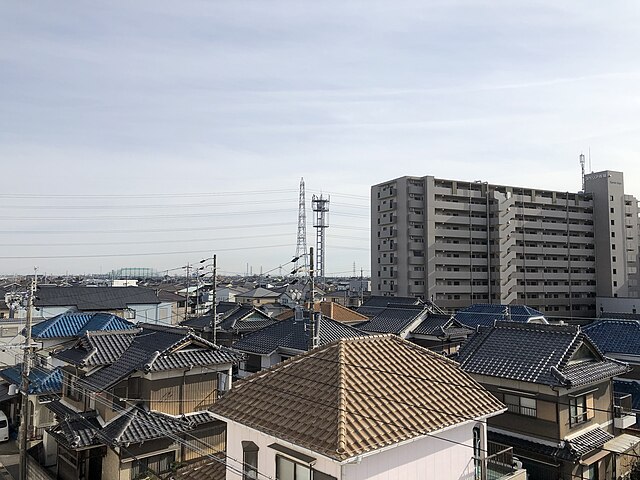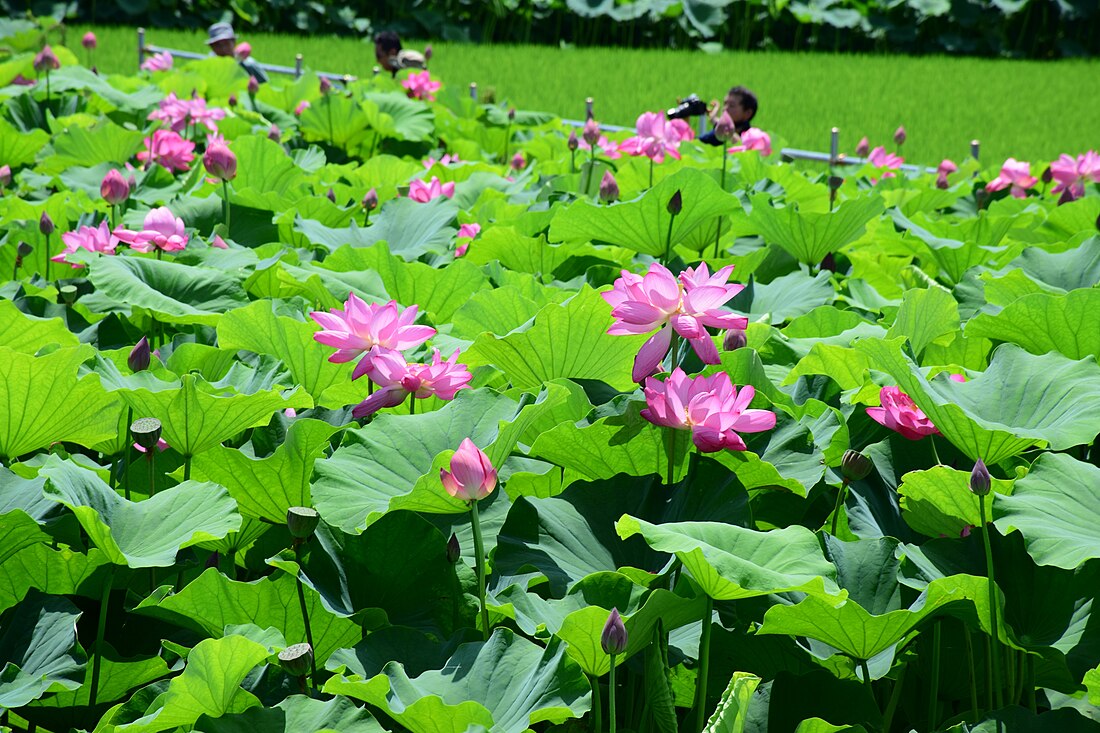Aisai
City in Aichi Prefecture, Japan From Wikipedia, the free encyclopedia
Aisai (愛西市, Aisai-shi) is a city located in Aichi Prefecture, Japan. As of 1 October 2019[update], the city had an estimated population of 61,320 in 23,451 households,[1] and a population density of 919 persons per km2. The total area of the city is 66.70 square kilometres (25.75 sq mi). Aisai is a member of the World Health Organization’s Alliance for Healthy Cities (AFHC).[2]
Aisai
愛西市 | |
|---|---|
 Morikawa lotus field | |
 Location of Aisai in Aichi Prefecture, highlighted in pink | |
| Coordinates: 35°9′10″N 136°43′41.6″E | |
| Country | Japan |
| Region | Chūbu (Tōkai) |
| Prefecture | Aichi |
| Area | |
• Total | 66.70 km2 (25.75 sq mi) |
| Population (October 1, 2019) | |
• Total | 61,320 |
| • Density | 920/km2 (2,400/sq mi) |
| Time zone | UTC+9 (Japan Standard Time) |
| Phone number | 0567-26-8111 |
| Address | Yoneno 308, Inaba-cho, Aisai-shi, Aichi-ken 496-8555 |
| Climate | Cfa |
| Website | Official website |
| Symbols | |
| Flower | Nelumbo nucifera |
| Tree | Podocarpaceae |

Geography
Summarize
Perspective
Aisai is located in the coastal flatlands of far western Aichi Prefecture, bordering Gifu Prefecture to the west. It has a short border with Mie Prefecture to the southwest. The Kiso River and the Nagara River pass through the city.
Climate
The city has a climate characterized by hot and humid summers, and relatively mild winters (Köppen climate classification Cfa). The average annual temperature in Aisai is 15.6 °C (60.1 °F). The average annual rainfall is 1,729.9 mm (68.11 in) with September as the wettest month. The temperatures are highest on average in August, at around 27.7 °C (81.9 °F), and lowest in January, at around 4.2 °C (39.6 °F).[3]
| Climate data for Aisai (1991−2020 normals, extremes 1979−present) | |||||||||||||
|---|---|---|---|---|---|---|---|---|---|---|---|---|---|
| Month | Jan | Feb | Mar | Apr | May | Jun | Jul | Aug | Sep | Oct | Nov | Dec | Year |
| Record high °C (°F) | 17.5 (63.5) |
21.1 (70.0) |
24.8 (76.6) |
29.1 (84.4) |
33.6 (92.5) |
36.8 (98.2) |
39.3 (102.7) |
40.3 (104.5) |
37.9 (100.2) |
31.8 (89.2) |
25.7 (78.3) |
22.0 (71.6) |
40.3 (104.5) |
| Mean daily maximum °C (°F) | 8.8 (47.8) |
9.9 (49.8) |
13.8 (56.8) |
19.5 (67.1) |
24.2 (75.6) |
27.4 (81.3) |
31.2 (88.2) |
33.0 (91.4) |
28.9 (84.0) |
23.1 (73.6) |
17.1 (62.8) |
11.3 (52.3) |
20.7 (69.2) |
| Daily mean °C (°F) | 4.2 (39.6) |
4.9 (40.8) |
8.4 (47.1) |
13.8 (56.8) |
18.8 (65.8) |
22.6 (72.7) |
26.5 (79.7) |
27.7 (81.9) |
23.8 (74.8) |
17.9 (64.2) |
11.8 (53.2) |
6.5 (43.7) |
15.6 (60.0) |
| Mean daily minimum °C (°F) | 0.2 (32.4) |
0.6 (33.1) |
3.6 (38.5) |
8.7 (47.7) |
14.1 (57.4) |
18.8 (65.8) |
22.9 (73.2) |
23.9 (75.0) |
20.0 (68.0) |
13.7 (56.7) |
7.3 (45.1) |
2.2 (36.0) |
11.3 (52.4) |
| Record low °C (°F) | −7.8 (18.0) |
−8.5 (16.7) |
−7.5 (18.5) |
−0.8 (30.6) |
4.7 (40.5) |
12.0 (53.6) |
16.2 (61.2) |
15.8 (60.4) |
10.6 (51.1) |
2.0 (35.6) |
−1.7 (28.9) |
−6.0 (21.2) |
−8.5 (16.7) |
| Average precipitation mm (inches) | 57.2 (2.25) |
67.9 (2.67) |
122.8 (4.83) |
149.3 (5.88) |
175.1 (6.89) |
213.2 (8.39) |
223.5 (8.80) |
164.3 (6.47) |
244.0 (9.61) |
166.6 (6.56) |
82.1 (3.23) |
64.0 (2.52) |
1,729.9 (68.11) |
| Average precipitation days (≥ 1.0 mm) | 6.9 | 7.2 | 9.6 | 9.7 | 10.1 | 11.9 | 12.5 | 9.1 | 11.2 | 9.1 | 6.7 | 7.6 | 111.6 |
| Mean monthly sunshine hours | 157.5 | 161.3 | 192.0 | 196.8 | 200.5 | 153.9 | 171.1 | 210.2 | 160.1 | 163.2 | 152.2 | 148.7 | 2,067.5 |
| Source: Japan Meteorological Agency[4][3] | |||||||||||||
Demographics
Per Japanese census data,[5] the population of Aisai has been relatively steady over the past 30 years.
| Year | Pop. | ±% |
|---|---|---|
| 1960 | 38,629 | — |
| 1970 | 48,104 | +24.5% |
| 1980 | 61,337 | +27.5% |
| 1990 | 63,143 | +2.9% |
| 2000 | 65,597 | +3.9% |
| 2010 | 64,981 | −0.9% |
Surrounding municipalities
History
Early modern period
During the Edo period, the area of modern Aisai was controlled by the Yokoi clan, retainers of the Owari Tokugawa of Nagoya.
Late modern period
During the Meiji period, the area was organized into several villages under Kasai District and Kaito District, Aichi Prefecture, which later became Ama District, Aichi in the Taishō period.
Contemporary history
The city of Aisai was created through the merger on April 1, 2005 of the towns of Saya and Saori and villages of Hachikai and Tatsuta.
Government

Aisai has a mayor-council form of government with a directly elected mayor and a unicameral city legislature of 18 members. The city contributes one member to the Aichi Prefectural Assembly. In terms of national politics, the city is part of Aichi District 8 of the lower house of the Diet of Japan.
Economy
Aisai is noted for its production of edible lotus root. Other main agricultural include ginger, strawberries, tomatoes, and the brewing of sake.
Education
Aisai has twelve public elementary schools and eight public junior high schools operated by the city government, and two public high schools operated by the Aichi Prefectural Board of Education. There are also two private high schools. The prefecture also operates one special education school for the handicapped.
Transportation

Railways
Conventional lines
- Kansai Main Line:- Eiwa -
- Tsushima Line:- Shobata – Fujinami -
- Bisai Line:- Saya – Hibino --(Tsushima)-- Machikata--(Inazawa)--Fuchidaka -
Roads
Expressways
Japan National Route
Local attractions

- Kokie castle
- Morikawa lotus field
Notable people from Aisai
- Ryoji Kuribayashi, professional baseball pitcher for Hiroshima Toyo Carp and 2021 Central League Rookie of the Year
- Katō Takaaki, pre-war Prime Minister of Japan
- Daiki Wakamatsu, professional soccer player
- Shoichi Yokoi, Imperial Japanese Army holdout found in Guam
Gallery
- Saya district Aisai city Aerial photograph
- Kracie Tsushima Factory
- MT-Saya Station-Building
- Nagaragawa Bridge and Tatsuta Bridge
References
External links
Wikiwand - on
Seamless Wikipedia browsing. On steroids.







